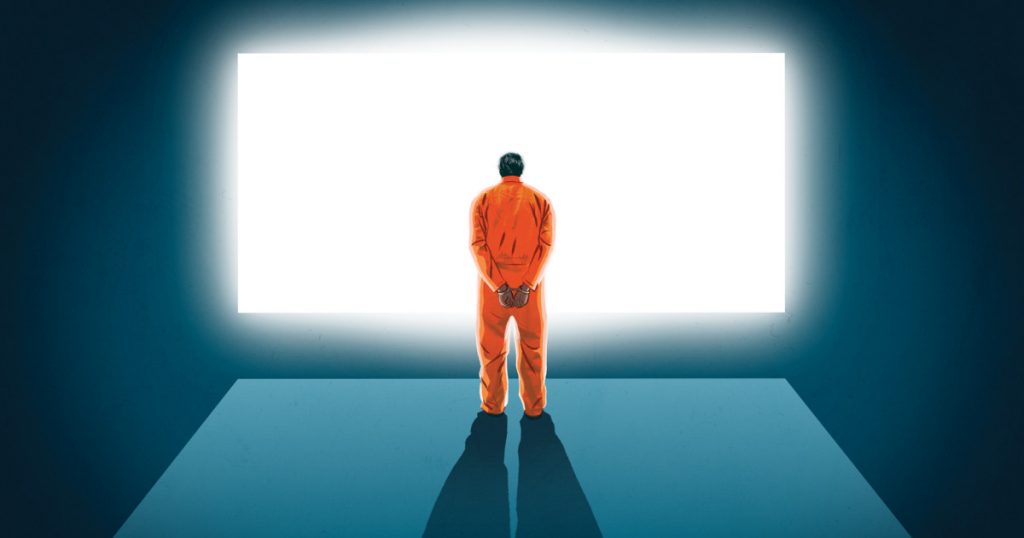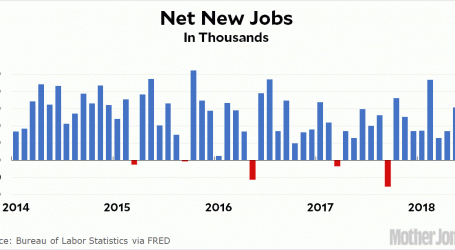How Trial by Skype Became the Norm in Immigration Court
Looking for news you can trust?Subscribe to our free newsletters.
Rob DobiTess Feldman stood in an empty San Francisco courtroom, facing a three-foot-wide television screen. “Good morning!” she shouted toward a camera connected to the TV. “Can you hear me?”
A stunned-looking man in an orange prison jumpsuit appeared on screen. An inmate at the Mesa Verde Detention Facility in Bakersfield, California, nearly 300 miles away, he was facing deportation and weighing his legal options. His father had been murdered back in Oaxaca, Mexico, he told Feldman, and he was afraid to return. That made him a potential candidate for asylum, but he worried he would sit in a cell for months as his case wended through the courts. “That takes a long time, right?” he asked.
“Yes,” Feldman said. She checked her phone for the time. “I’m so sorry, but we only have one minute left to talk.”
“I’ll think about it,” he said, and walked offscreen, shoulders slumped.
Twice a month, Feldman, a senior immigration attorney for a Bay Area legal nonprofit, serves as the counsel of the day for detainees at Mesa Verde and other facilities. She has two hours to interview approximately 18 inmates—six minutes each. Because Mesa Verde is a five-hour drive from San Francisco, home to one of the nearest major immigration courts, almost all these detainees will never actually go in person, but will instead appear before judges—and meet their pro bono lawyers—via video teleconference.
Detainees appearing via video give up more quickly and resign themselves to self-deportation.To detainees and their attorneys, video teleconference, or VTC, is an ad hoc solution and a valuable time-saving measure. As of 2015, nearly one-third of detained immigrants in the United States appeared in deportation hearings via televideo. In 2017, there were 114,000 hearings that used VTC, a 185 percent increase since 2007.
As VTC becomes increasingly entrenched in the detention process, advocates and immigration officials have to weigh its efficiency at expediting court proceedings against the pressures it puts on asylum-seekers. A study published in the Northwestern University Law Review found that “detained televideo litigants were more likely than detained in-person litigants to be deported.” The reason? Judges don’t necessarily adjudicate their cases differently; rather, detainees appearing via video give up more quickly and resign themselves to so-called self-deportation.
For the first six months of Donald Trump’s presidency, 7,086 people opted to go home before seeing a judge—58 percent more than during the same time period the year before under President Barack Obama. “Detention itself is a litigation strategy to demoralize people and creates an easier deportation process,” says Graeme Crews of the Southern Poverty Law Center.
The rise of trial by screen is a result of two factors: a massive spike in the number of immigrants in detention, begun under Obama and ramped up by Trump, and the increasingly remote locations of the facilities that house them. Today, 34,000 immigrants are detained at any one time nationwide, and within the first month of Trump’s presidency, his administration promised to “take all necessary action and allocate all available resources” to expand detention facilities. In April 2017, a confidential Department of Homeland Security “Progress Report to the President” stated that Immigration and Customs Enforcement had identified “27 potential locations capable of providing 21,000 additional bed spaces,” and suggested reopening two 500-bed centers in the Texas hinterlands. On October 12, DHS issued a public request for information to identify possible detention sites for immigrants within 180 miles of Chicago, Detroit, Salt Lake City, or St. Paul, Minnesota—up to three hours away from the nearest immigration courts and most pro bono lawyers.
Working by video presents practical challenges for immigrant advocates. Preparing asylum cases often requires probing clients’ most horrific life experiences in detail—rape, police brutality, death threats—in order to gather evidence to bolster their claims. Take Josue, one of Feldman’s clients, who came from El Salvador three years ago. I met him in a small, overly air-conditioned conference room at Mesa Verde. The facility, a massive concrete structure on the outskirts of Bakersfield, is a renovated former prison that houses up to 400 inmates awaiting deportation hearings. (Mesa Verde’s contract requires the government to keep 320 beds occupied at all times.) It took me nearly a full workday to drive there from San Francisco, where Josue’s asylum eligibility hearing was set to take place in a few days. Josue would conference in to the hearing by video. “I’d prefer to go in person,” he told me.
The case didn’t seem to be going well, and he felt it.Josue had been diagnosed with schizophrenia by a doctor at Mesa Verde. He’d explained to Feldman, who’d only been able to visit him twice, that he was the victim of several brutal beatings by the gang MS-13 in El Salvador, and that his wife, who lives in the Bay Area and has a child with a current MS-13 leader, had received threats since taking up with Josue. Legally speaking, his case was made all the more complicated by the fact that he had a criminal record, including an assault conviction. Feldman thought that a recent federal court ruling might allow Josue to seek a hearing in person due to his mental-health diagnosis. However, the petition process would have taken months. He was desperate to get out, so he opted to go ahead via video teleconferencing.
As we spoke, he had trouble keeping track of dates and specific events, a tendency that signaled to Feldman early on that he might have cognitive challenges. He couldn’t always remember the details of his three assaults by MS-13, and in the attempt to recall them he became agitated. The circumstances of his detention put him on edge, too. “You never know if they are gangsters or not,” he said of his fellow inmates. “So it’s best just to keep quiet.”
Two days later, in the courtroom in San Francisco, the picture on the screen came into focus and Josue appeared, nervous, clad in red, hair combed back. Feldman leaned forward to wave to the camera. Josue meekly waved back.
Over the next 30 minutes, as Feldman had feared, Josue had trouble recalling the exact dates of the MS-13 attacks. Key points of discussion between the judge and lawyers went untranslated, and as the morning wore on, Josue appeared more and more skittish. The case didn’t seem to be going well, and he felt it. It was easy to see why he might choose voluntary deportation.
Ultimately, the hearing was reset for another day; the judge wanted to see more evidence from Josue’s wife regarding previous threats back in El Salvador. For Josue, this was a good sign. But it meant more time in detention, far from his family. He would have to hold out a little longer.
A few weeks after Josue’s hearing, I received an email from Feldman. Josue’s case, she wrote, was denied. He’d never once been inside a courthouse, never spoken to a judge except by video camera. “He will be returning on the next flight.”





